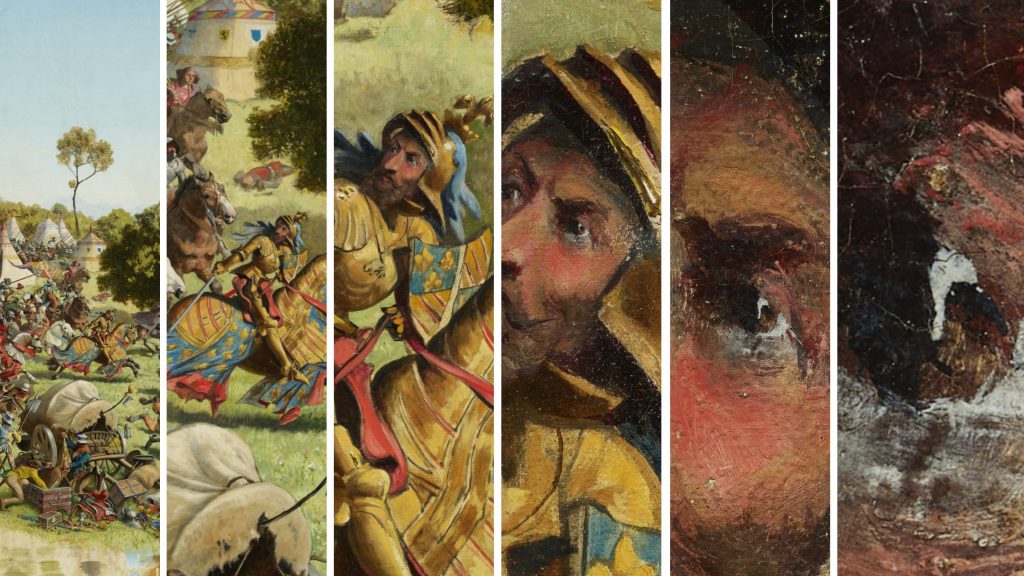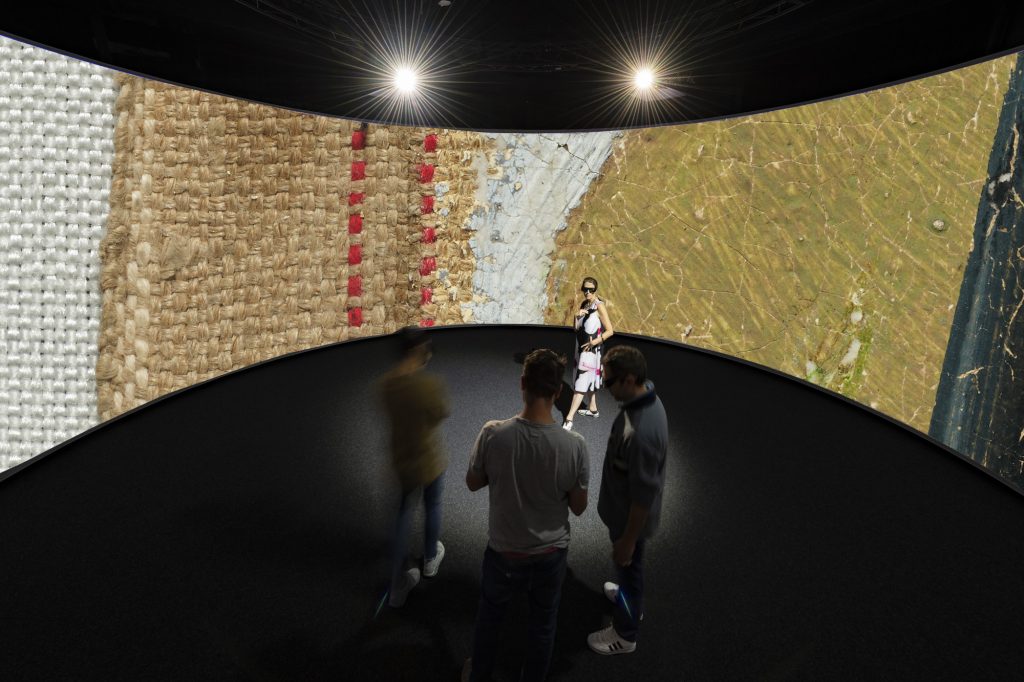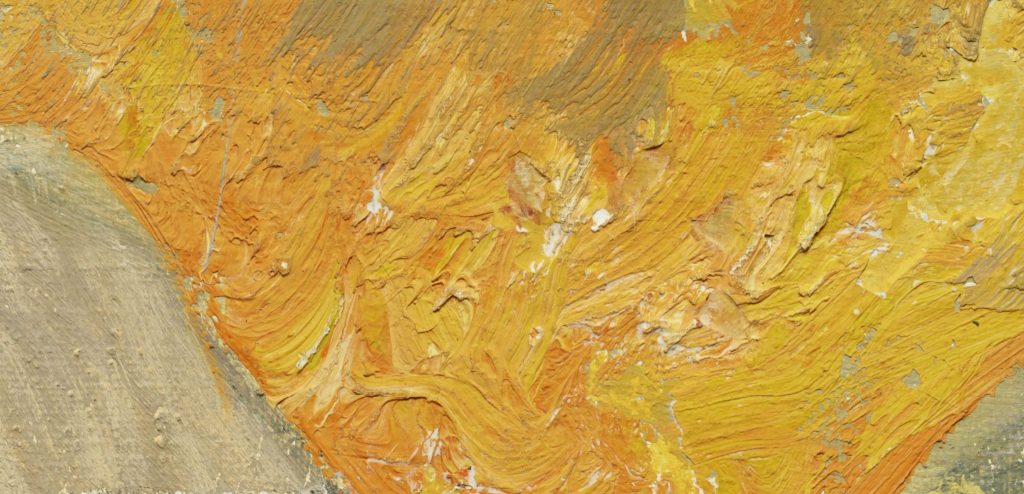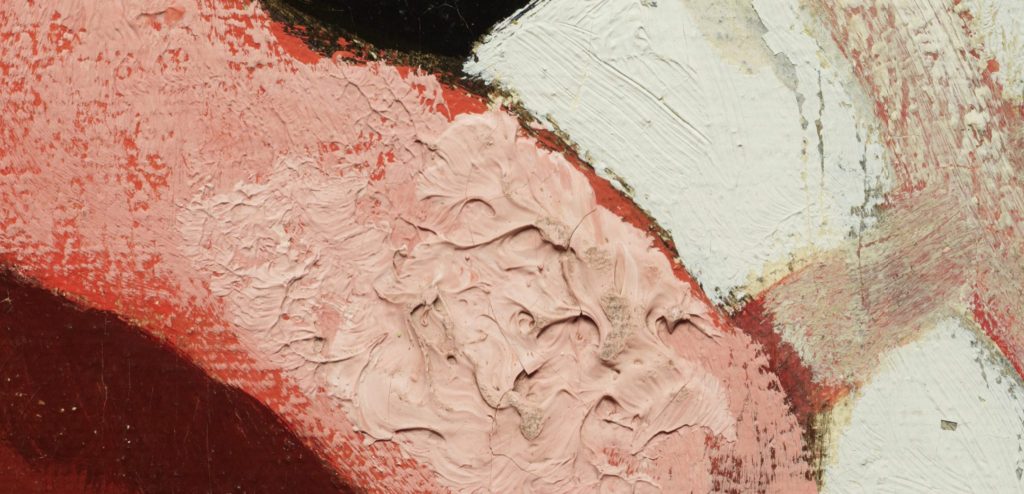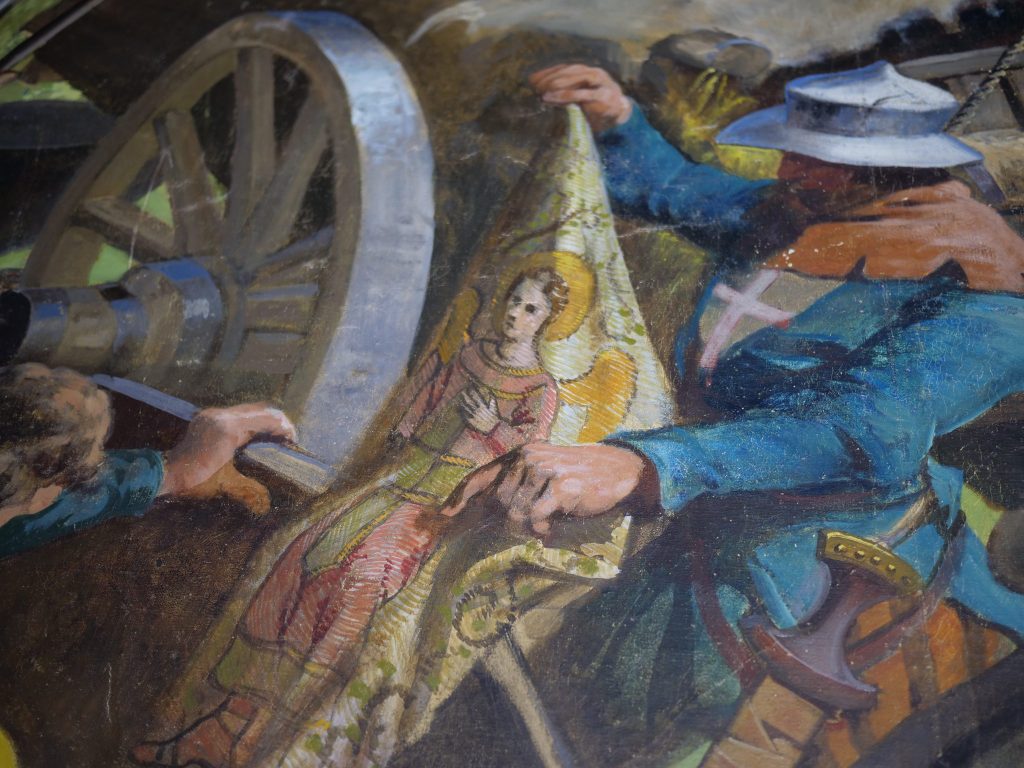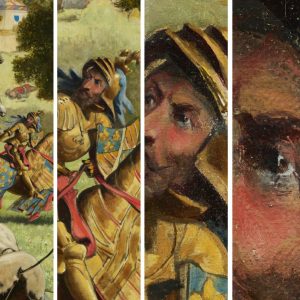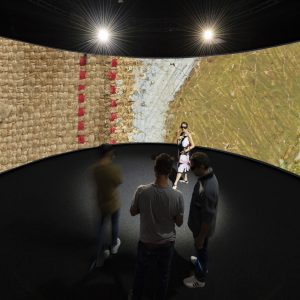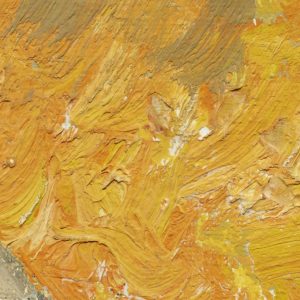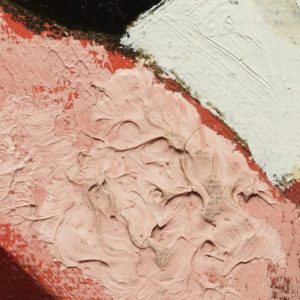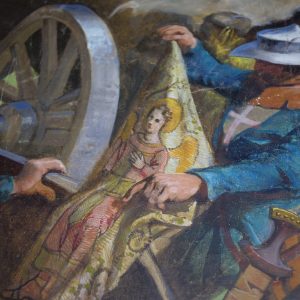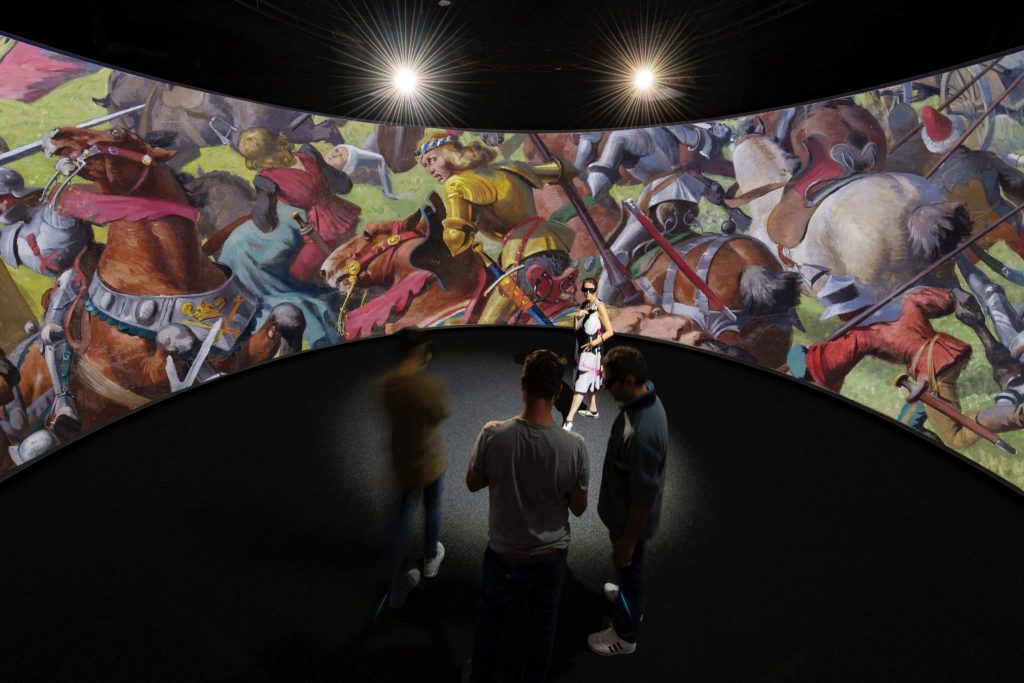
The imaging of this national treasure, a panorama painting spanning 1,000 m2, has produced a digital twin: the largest digital image of a single object ever produced (1,600 Gigapixel). From this state-of-the-art image, a series of innovative, interactive museum installations will be designed in the context of the 550th anniversary of the Burgundian wars (2026).
The panorama of the battle of Murten celebrates a victory that irrevocably altered Swiss and European history. This event has been continuously commemorated, but only once in panoramic display. The panorama represents a late-19th century vision of a Medieval battle instrumental in political discourse. Today, its societal and cultural meaning has changed. The DIAGRAM project intends to offer a critical analysis of the 19th-century image and to offer new approaches for cultural interpretation.
Project Phases
1. The Terapixel Panorama — creating the digital twin
2. Augmenting and annotating — the digital twin
3. Exhibitions — list of exhibitions (coming soon)
Project team
Prof. Sarah Kenderdine (lead)
Dr. Daniel Jaquet (project manager & military historian)
Dr. Paul Bourke (image specialist)
Nelissen Decorbouw (conservation and scanning platform engineer)
Raphael Chau (PhD student in digital humanities)
Tonia Ramogida (researcher in digital humanities)
Marinella Sofia Gkinko (science communicator)
eM+ software engineers: Samy Mannane, Loïc Serafin and Adriano Viegas Milani alongside numerous other collaborators.
This project is made possible by the SNF, essential donors and the custodian of the panorama, The Stiftung für das Panorama der Schlacht bei Murten (1476). See Impressum below.
EPFL Press releases
EPFL lab to digitize 1,000m2 ‘Swiss national treasure’
The Digitisation of the Panorama of Murten is about to start
National Press (update November 1, 2023)
DIAGRAMPressreview22-23-1Download
Media Coverage
Gobbo, S. (2024, November 6). ‘La bataille de Morat, comme si vous y étiez; «On passe du tumulte de la bataille au son du pinceau»‘. Le Temps.
‘Le GIFF expose à Genève la version numérique du fameux panorama de la bataille de Morat‘. (2024, November 7). Radio Télévision Suisse.
The object
The painting depicts the moment Swiss Confederates gained the upper hand against the Duchy of Burgundy during its 1476 invasion, a turning point in European history. Commissioned by a Swiss society specialized in public entertainment, the panorama was the main media of the end of the 19th c. The artist, Louis Braun, was a famous painter of German military history. Braun and his team produced this work measuring 10 x 100 m in 1893. It was on display in Zurich, then Geneva (1894-1907), before falling in oblivion behind the new media of the cinema. Rediscovered in 1996, it was restored and put on a brief display for 4 months during Expo.02 (2002) in a monolith built by Jean Nouvel on the Murten lac. Since then, it remained rolled up in a Swiss Army deposit.

The imaging process
For a full description see The Terapixel Panorama Project
In June, 2022, the panorama of the battle of Murten was transported to the EPFL Laboratory for Experimental Museology . The design of the custom-built inspection platform ran parallel to the first inspections and tests (August-December 2022). The conservation of the 3 rolls was performed parallel to the design and production of the scanning rig (January-June 2023). The scanning process took place between August and October 2023, after which the panorama was returned to its storage location. The post-processing of the image data and first tests took place in November – January 2024.
The imaging, provided by camera systems manufacturer, Phase One, took advantage of an iXH 150-megapixel camera with a 72mm lens specifically built for high-resolution digitization projects.. The process took four months, capturing 27,000 images within and beyond the RGB (red, green, and blue) color spectrum. The challenges of producing an image of 1,6 terapixel with high color fidelity at a resolution of 1000 dots per inch are both physical and technical.
Physical challenges include capturing a flawless 2D picture despite irregularities on the canvas’s surface. The original canvas is also hyperboloid in shape, as it was intended to be installed vertically for display in a rotunda (spherical building/room). The painting has therefore been carefully ‘spooled’ across a substrate to ensure smooth image capture.
The challenges posed by the size, quality and high technological aspects of the digital twin are the subject of scientific research and experimentation during the imaging phase. They allow for scientific contributions in the fields of data science, conservation, and historic panoramas. It includes the use of block chain technologies, the post-processing of stitched images, and digital conservation. More information can be found on the publications related to the project.
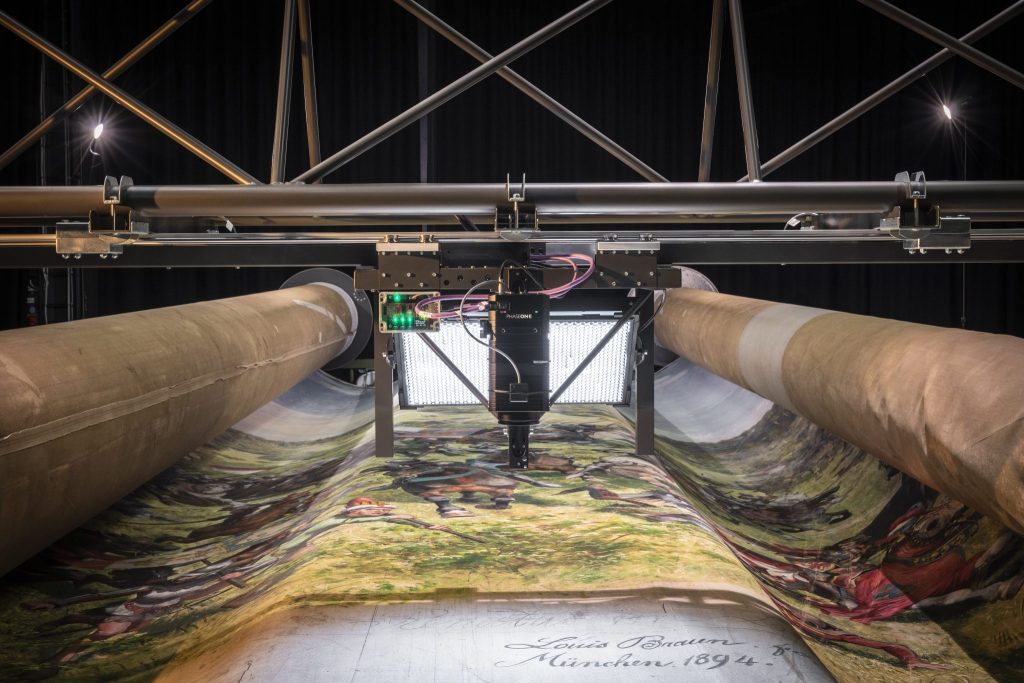
Augmentation of the panorama (2024-2026)
The scanning of the Battle of Murten Panorama canvas gives rise to a range of interpretation projects from ultra-high resolution streaming online, to highly significant situated experiences of the panorama akin to what the original experience would have been like but with the aid of spectacular software initiated interactive audio visual effects. Four special exhibitions are planned in 2025-2026 at the Castle of Grandson, Museum für Gestaltung, Museum Murten, and Bernisches Historisches Museum. The update for a more detailed schedule of the exhibition is planned in November 2024.
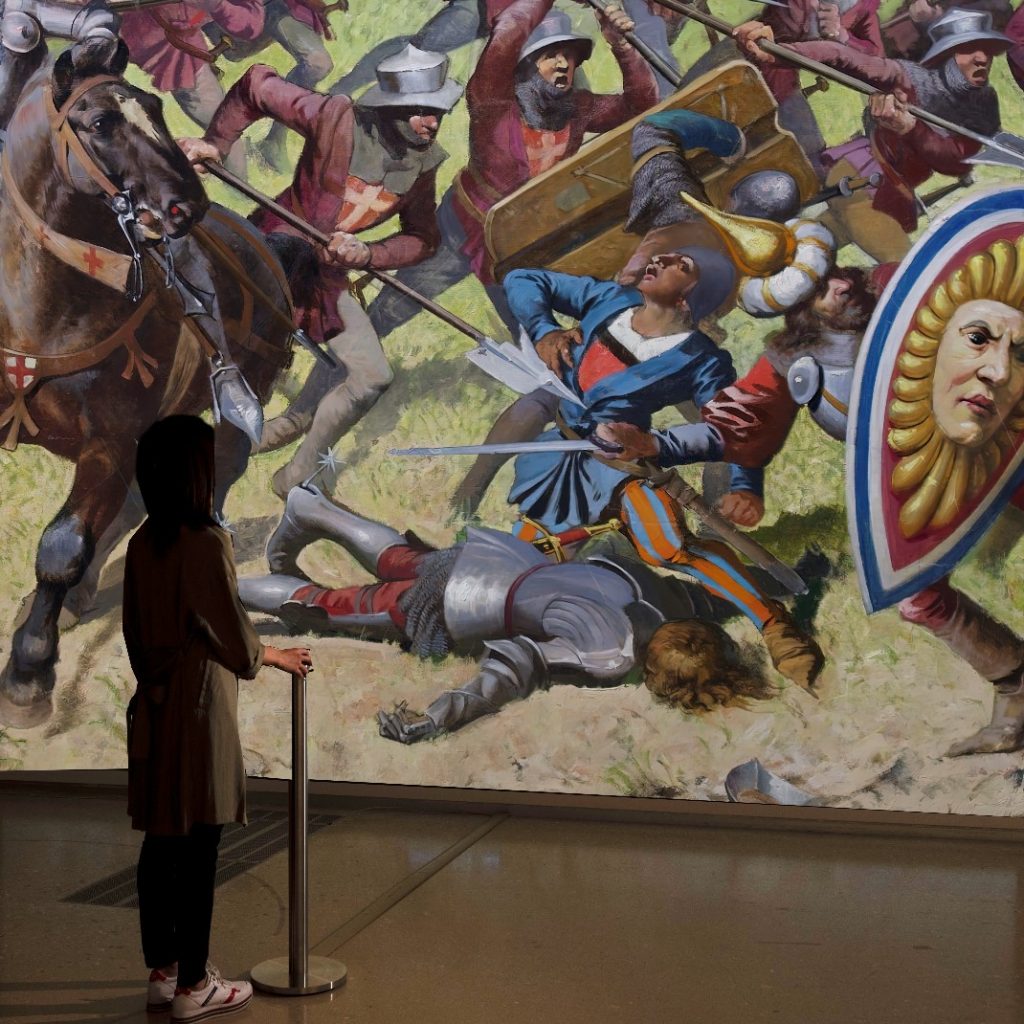
Additional datasets
Next to the zooming and panning options available at an unprecedented resolution, additional content will be produced to enrich the digital twin. It will guide public access to and understanding of the artwork. These augmentations are superimposed on the original image. Additional datasets will include 3D models of objects, volumetric videos, and motion capture of scenes in the painting, situated within a historically informed soundscape based on research into Medieval chronicles, letters, narrative literature, and other archival documents that mention sound in battles. Research into the material culture evidenced in the panorama has identified dozens of related artifacts held in Swiss museums, such as costumes, weapons, or accessories. Synthetic smells diffused on experimental devices will allow the exploration of the fragrant environment of the battlefield.

Special project’s website
The website will be key to transmit and deepen engagement with both the exhibitions and the 2026 Burgundian wars commemorations. The digital twin will be displayed at the highest resolution supported by web browsers. The website will feature other content from the exhibition system version such as 3D models, volumetric videos of reenactors, and a 2D video of the installation being experienced live by visitors. The project database will be made available through Linked Open Data related to the digital twin (links and metadata to images and text). It will notably include a selection of primary sources connected to both the history of the panorama and the context of the battle of Murten. This includes all the recently digitized preparatory drawings by Louis Braun and archives related to the production of the panorama, as well as an augmented edition using Text Encoding Initiative (TEI) standards of the collection of primary sources by Ochsenbein (1876). Enabled by semantic web technologies and IIIF manifest, data can now be curated down to the image region level. Additionally, this website will launch a novel annotation tool that will support future storytelling for narrative rich paintings.
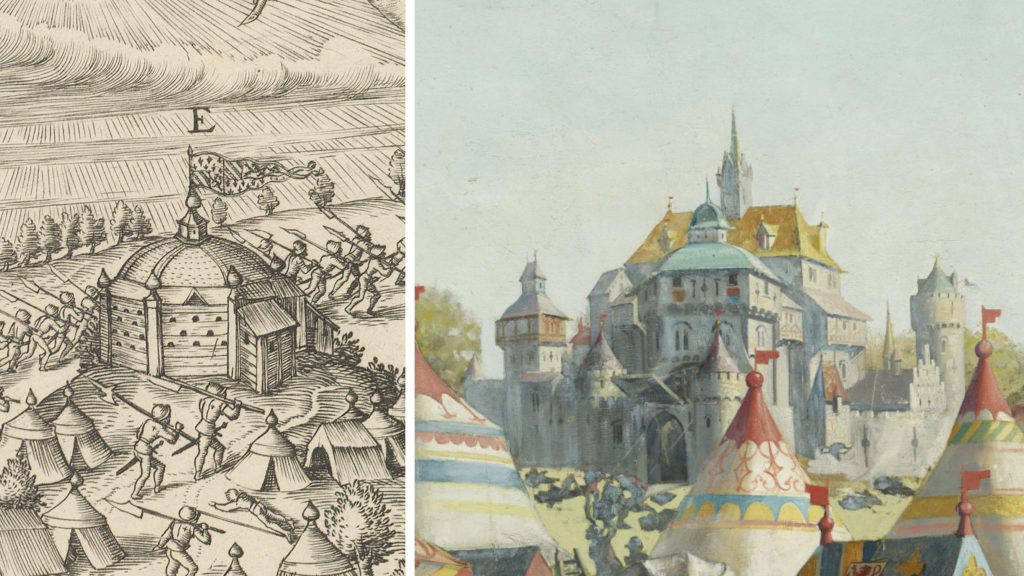
Exhibitions
-
GIFF (Geneva International Film Festival), Geneva
Dates: 1-10 November 2024
Venue: GIFF
System: 5m wide back projected screen
Context: group exhibition -
Swiss Month, Hong Kong (Swiss Consulate in Hong Kong)
Dates: 09-11 November 2024
Venue: Hong Kong Baptist University, Visualization Research Centre
System: 10 metre diameter, 360-degree interactive LED system
Context: standalone installation -
Museum für Gestaltung, The Museum of the Future
Dates:28 August 2025—18 January 2026
Venue: Museum für Gestaltung, Ausstellungsstrasse
System: 9 metre wide, 120-degree interactive projection system
Context: group exhibition -
Murten Museum
Dates: 12 January 2026—4 April 2026
Venue: Murten Museum, Murten
System: interactive projection mapping
Context: projection installation integrated into the Museum architecture -
Bernisches Historisches Museum
Dates: February 2026—May 2027
Venue: Bernisches Historisches Museum, Bern
System: 360-degree interactive projection system
Context: main installation in exhibition -
Castle of Grandson
Dates: September—November 2026
Venue: Castle of Grandson, Grandson
System: 6 metre diameter, 360-degree interactive Panoramic Navigator
Context: standalone installation

Impressum
A project of the EPFL CDH-DHI Laboratory for Experimental Museology, in partnership with the Foundation for the Panorama of the Battle of Murten. The first phase of this project (imaging) was supported by Loterie Romande, Municipality of Murten, Canton of Fribourg, Federal Office for Culture, the Association of the Friends of the Panorama, and the Foundation Etrillard. Phase Onetm is a sponsor for this project. The second phase of the project (augmentation) is supported by Swiss National Science Foundation, Ernst Göhner Stiftung, Stiftung für Kunst, Kultur und Geschichte, UBS Culture Foundation, Foundation Etrillard, and Association Suisse pour l’Histoire et les Sciences Militaires.
Publications about the project
Jaquet, D., & Kenderdine, S. (2020). ‘The Murten Panorama, from 2D to 4D’. International Panorama Council Journal 3: 102–9.
Jaquet, D. (2021). ‘Le Panorama de la bataille de Morat version 2.0‘. Annales Fribourgeoises 83(2): 49‑53.
Chau, TK., Bourke, P., Hibberd, L., Jaquet, D., & Kenderdine, S. (2024). ‘Cultural Big Data: Nineteenth to Twenty-first Century Panoramic Visualization’. Frontiers in Big Data: Data Mining and Management 7. DOI 10.3389/fdata.2024.1309887
Jaquet, D. & Kenderdine, S. (2024). ‘The Digitization of the Murten Panorama: Notes on the Creation of the World’s Largest Image’. Panoramic and Immersive Media Studies Yearbook 1. DOI: 10.1515/9783111335575-022
About the Foundation for the Panorama of the battle of Murten
Stiftung für das Panorama der Schlacht bei Murten (1476)
Leaflet on historic panoramas
Deicher, P., Koller, G., & Jaquet, D. (trsl) (2024). ‘Historic Panoramas of the World: The Fascination of a Visual Mass Medium of the 19th and Early 20th Centuries.’ Lucerne: Bourbaki Panorama Museum.
Publications focused on panoramic media and theory
Books
Kenderdine, S. (2013). Place-Hampi: Inhabiting the panoramic imaginary of Vijayanagara, Heidelberg: Kehrer Verlag.
Frank, I., Feneley, M., Kenderdine, S. & J. Shaw (2021), The Atlas of Maritime Buddhism. Hong Kong: City University Press.
Chapters
Kenderdine, S. (2021). ‘Experimental museology: Immersive visualization and cultural (big) data’, in (eds) M. Achiam, M. Haldrup and K. Drotner, Experimental Museology Institutions, Representations, Users. Abingdon: Routledge: 15-34.
Kenderdine, S. (2020). ‘Omnidirectional Strategies for Exploring Ancient Cities and Territories’, in M. Forte & H. Murteira (eds.), Digital Cities: Between History and Archaeology. Oxford: Oxford University Press, 185-206.
Kenderdine, S. (2016). ‘Embodiment, entanglement and immersion in digital cultural heritage’ in S. Schreibman, R. Siemens & J. Unsworth (eds.), A New Companion to Digital Humanities. John Wiley & Sons Ltd, 22–41.
Kenderdine, S. & J. Shaw. (2014) ‘A Cultural Heritage Panorama: Trajectories in Embodied Museography’, in H. Din and S. Wu (eds), Digital Heritage and Culture – Strategy and Implementation, Singapore: World Scientic Publishing Co: 197-218.
Kenderdine, S., Shaw, J. & T. Gremmler, T. (2012) ‘Cultural Data Sculpting: Omnidirectional Visualization for Cultural Datasets’, in F.T. Marchese and E/ Banissi (eds), Knowledge Visualization Currents: From Text to Art to Culture. London: Springer-Verlag: 199-221.
Kenderdine, S. (2007) ‘Speaking in Rama: Panoramic Vision in Cultural Heritage Visualisation’, in F. Cameron and S. Kenderdine (eds), Theorizing Digital Cultural Heritage: A Critical Discourse. Cambridge: MIT Press: 301-332.
Kenderdine, S., J. Shaw, D. del Favero & N. Brown. (2007). ‘Place-Hampi: Co-Evolutionary Narrative and Augmented Stereographic Panoramas, Vijayanagara, India’, in (eds) Y. Kalay, T. Kvan and J. Affleck, New Heritage: New Media and Cultural Heritage. Abingdon & Oxford: Routledge: 336-352.
Journals
Kenderdine, S. (2021). ‘Prosthetic architectures of the senses: museums and immersion’, in (eds) M. Beugnet & L. Hibberd, dossier: ‘Absorbed in Experience: new perspectives on immersive media’, Screen 61(4): 635-645. Kenderdine, S. & T. Hart. (2014). ‘mARChive: Sculpting Museum Victoria’s Collections’, Museums and the Web: Proceedings, 2-5 April 2014, Baltimore.
Kenderdine, S. & Lancaster, L. (2014). ‘Cultural Data Sculpting: The Tripitaka Koreana’, in Nhat Tur, Đuc Thien and Lancaster, L (eds), Proceedings of Buddhist Culture and Technology: New Strategies for Study, Ninh Binh: Vietnam Buddhist University.
Kenderdine, S. (2013). ‘Pure Land: Inhabiting the Mogao Caves at Dunhuang’, Curator: The Museum Journal 56(2): 199-118.
Kenderdine, S. & Hart, T. (2011) ‘Cultural Data Sculptin g: Omni-Spatial Visualization for Large Scale Heterogeneous Datasets’, in Museums and the Web 2011: Proceedings, Philadelphia, 6-9 April.
Kenderdine, S., Lancaster, L., Lan, H. & Gremmler, T. (2011). ‘Omnidirectional 3D Visualization for the Analysis of Large-Scale Textural Corpus: Tripitaka Koreana’, in Proceedings of The Second International Conference on Culture and Computing, Kyoto: IEEE, pp. 27-32.
Kenderdine, S. (2010). ‘PLACE-Hampi, Ancient Hampi and Hampi-LIVE: An Entanglement of People- Things’, in M. Forte (ed.), Cyber-Archaeology, British Archaeological Reports, Oxford: Bar Publishing, pp. 47-62.
Kenderdine, S., Shaw, J. & Kocsis, A. (2009). ‘Dramaturgies of PLACE: Evaluation, Embodiment and Performance in PLACE-Hampi’, in Proceedings of the International Conference on Advances in Computer Entertainment Technology, Athens: ACM, pp. 249-56. Kenderdine, S. (2008). ‘An entanglement of people-things: Place-Hampi’, International Journal of Digital Cultural Heritage and E-Tourism (IJDCE): .139-156.
Kenderdine, S. (2007). ‘The Irreducible Ensemble: Place-Hampi’, in Proceedings of Virtual Systems and Multimedia (VSMM) 13th International Conference, Brisbane, in Revised Selected Papers Series: Lecture Notes in Computer Science, 4820, Berlin: Springer, pp. 58-72.
Kenderdine, S. (2007). ‘Somatic Solidarity, Magical Realism and Animating Popular Gods: Place- Hampi “Where Intensities Are Felt”’, in Proceedings of the 11th European Information Visualisation Conference, Zürich: IEEE, pp. 402-408. Kenderdine, S. (2004). ‘Stereographic Panoramas of Angkor, Cambodia’, in Proceedings: Virtual Systems and Multimedia (VSMM) 10th International Conference, Gifu: IOS Press, pp. 612-621.
Doornbusch, P. & Kenderdine, S. (2004). ‘Presence and Sound: Identifying Sonic Means to “Be There”’, in Proceedings of Consciousness Reframed, Beijing, pp. 67-70.
